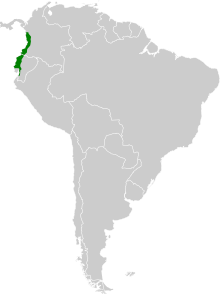| Brown wood rail | |
|---|---|

| |
| Conservation status | |
 Vulnerable (IUCN 3.1) | |
| Scientific classification | |
| Domain: | Eukaryota |
| Kingdom: | Animalia |
| Phylum: | Chordata |
| Class: | Aves |
| Order: | Gruiformes |
| Family: | Rallidae |
| Genus: | Aramides |
| Species: | A. wolfi |
| Binomial name | |
| Aramides wolfi Berlepsch & Taczanowski, 1884 | |

| |
The brown wood rail (Aramides wolfi) is a Vulnerable species of bird in the subfamily Rallinae of the rail, crake, and coot family Rallidae. It is found in Colombia and Ecuador.
Taxonomy and systematics
The brown wood rail is monotypic.
Description
The brown wood rail is 33 to 36 cm (13 to 14 in) long. The sexes are alike. Adults have a yellow-green bill, a red eye, and pink legs and feet. Their head is ashy gray with a yellow spot on the forehead and a pale throat. Their tail, flanks, and belly are black and the rest of their body is chestnut to warm brown. Immatures and juveniles have not been described.
The brown wood rail's specific epithet commemorates the German naturalist Theodor Wolf.
Distribution and habitat
The brown wood rail is patchily distributed in western Colombia and western Ecuador. A single 1977 report from Peru was retracted in 2011 and the South American Classification Committee of the American Ornithological Society does not recognize it. It inhabits a variety of wet and dry landscapes including mangroves, freshwater marsh, swampy woodland, river bottoms, and mature and secondary forest. In elevation it ranges from sea level to 900 m (3,000 ft).
Behavior
Movement
The brown wood rail appears to be a year-round resident throughout its range.
Feeding
Nothing is known about the brown wood rail's foraging methods or diet.
Breeding
The brown wood rail's breeding season in Ecuador spans at least February to April. Nests there were bulk open cups made of large dead leaves and bits of vine. Their placement varied, being on stumps, on branch or vine tangles, and in understory shrubs between 1.2 and 2.6 m (4 and 9 ft) above the ground. The clutch size was two to four eggs and the incubation period was at least 19 days.
|
Songs and calls Listen to brown wood rail on xeno-canto |
Vocalization
One call of the brown wood rail is a repeated "kui-co-mui".
Status
The IUCN originally assessed the brown wood rail as Threatened but since 1994 has classed it as Vulnerable. It is known from only a small number of locations. Its estimated population of 1000 to 2500 mature individuals is believed to be decreasing due to "rapid rates of habitat destruction". "There is an urgent need for further investigation of its status and natural history."
References
- ^ BirdLife International (2016). "Brown Wood-rail Aramides wolfi". IUCN Red List of Threatened Species. 2016: e.T22692581A93359785. doi:10.2305/IUCN.UK.2016-3.RLTS.T22692581A93359785.en. Retrieved 15 October 2022.
- ^ Gill, F.; Donsker, D.; Rasmussen, P., eds. (August 2022). "Finfoots, flufftails, rails, trumpeters, cranes, Limpkin". IOC World Bird List. v 12.2. Retrieved August 9, 2022.
- HBW and BirdLife International (2021) Handbook of the Birds of the World and BirdLife International digital checklist of the birds of the world. Version 6. Available at: http://datazone.birdlife.org/userfiles/file/Species/Taxonomy/HBW-BirdLife_Checklist_v6_Dec21.zip retrieved August 7, 2022
- ^ Remsen, J. V., Jr., J. I. Areta, E. Bonaccorso, S. Claramunt, A. Jaramillo, D. F. Lane, J. F. Pacheco, M. B. Robbins, F. G. Stiles, and K. J. Zimmer. Version 24 July 2022. Species Lists of Birds for South American Countries and Territories. https://www.museum.lsu.edu/~Remsen/SACCCountryLists.htm retrieved July 24, 2022
- ^ Taylor, B., E. F. J. Garcia, G. M. Kirwan, and E. de Juana (2020). Brown Wood-Rail (Aramides wolfi), version 1.0. In Birds of the World (J. del Hoyo, A. Elliott, J. Sargatal, D. A. Christie, and E. de Juana, Editors). Cornell Lab of Ornithology, Ithaca, NY, USA. https://doi.org/10.2173/bow.brwrai1.01 retrieved October 15, 2022
- Graves, G.R. (2011). Status of wood rails (Aramides) in mangroves in north-west Peru. Bull. Brit. Orn. Club. 131(3): 210–212
